
An Arctic front will bring widespread snow squalls through Friday from the Upper Midwest to the Ohio Valley. Heavy snow rates and strong winds will lead to near-zero visibility and dangerous travel conditions. High winds will continue across the northern and central High Plains through Friday, with wind gusts above 60 mph likely, leading to hazardous travel conditions. Read More >
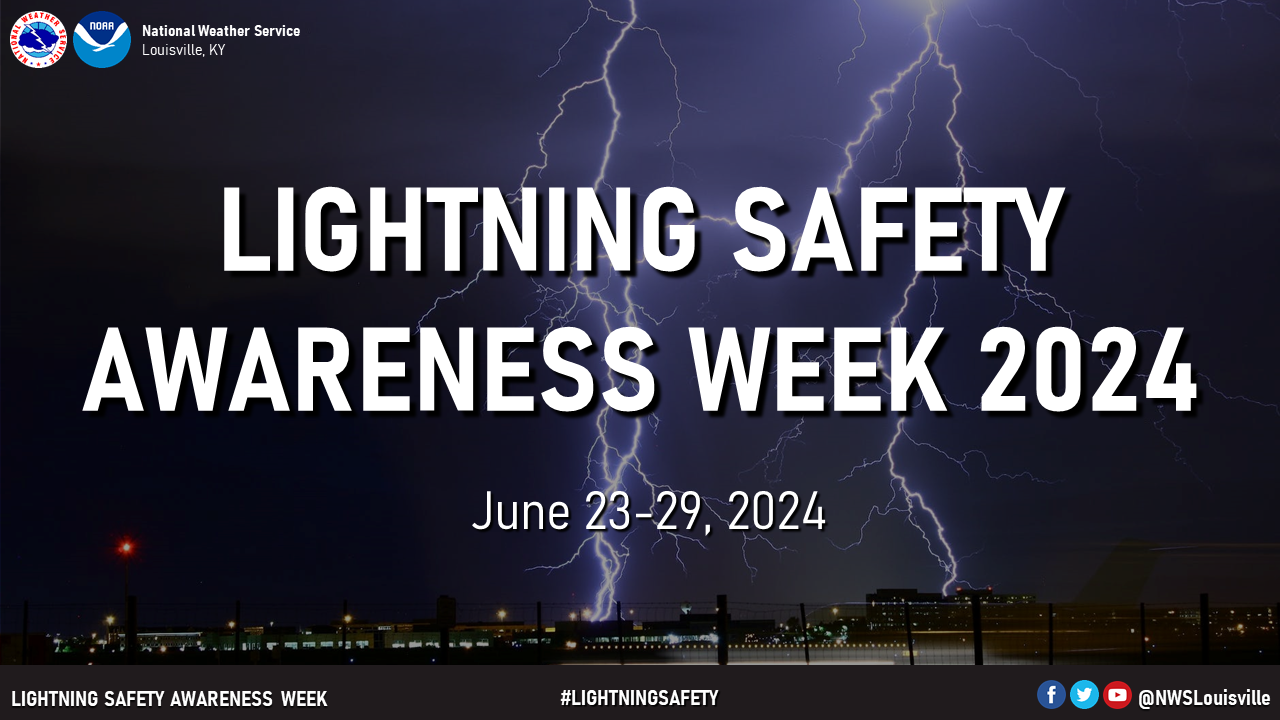
Lightning Safety Week is June 23 to June 29, 2024. Summertime across the Ohio Valley means barbecues, county fairs, sporting events, boating, hitting the beach, camping, and many other recreational activities. In short, summertime means a lot more people are spending a lot more time in the great outdoors. But summer is also the peak season for one of the nation's deadliest weather phenomena -- lightning. Lightning typically receives less attention than other storm-related killers because it does not result in mass destruction or mass casualties like tornadoes, floods, or hurricanes often do.
When Lightning Safety Awareness Week began in 2001, the United States averaged 50 deaths per year due to lightning. Now, the 10 year average number of lightning deaths per year in the US is 21. This reduction in lightning fatalities is largely due to greater communication of lightning danger and people taking action when thunder roars.
During this week, we will be sending out daily graphics on our social media platforms (Facebook and Twitter). Please Share/Retweet to share this knowledge with others.
Lightning Stats
The statistics shown were results from a study conducted by the National Lightning Safety Council and the National Weather Service. So far for 2024, there has been one fatality from lightning. Besides 2016, the total number of lightning fatalities has been at or below average. From 2006-2024, 481 people were struck and killed by lightning in the United States. Almost two thirds of the deaths occurred to people who had been enjoying outdoor leisure activities.
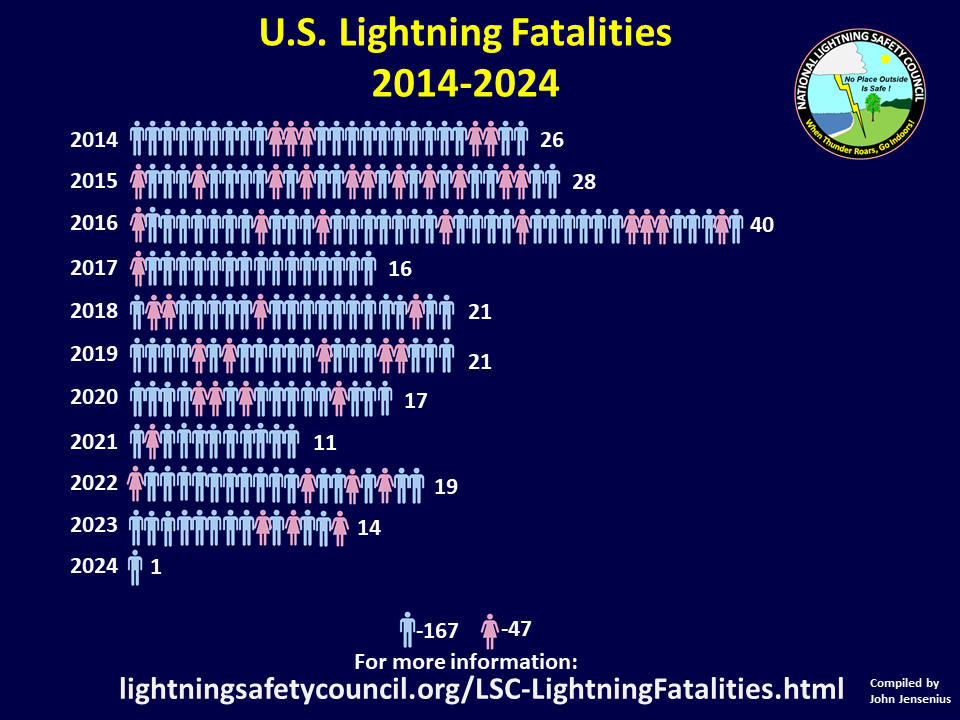
Compared to the rest of the United States, Kentucky and Indiana are among the states with the fewest lightning fatalities. The last lightning fatality in Kentucky occurred in 2023. The last lightning fatality in Indiana occurred in 2020. The last lightning fatality in the NWS Louisville County Warning Area was in 2013.
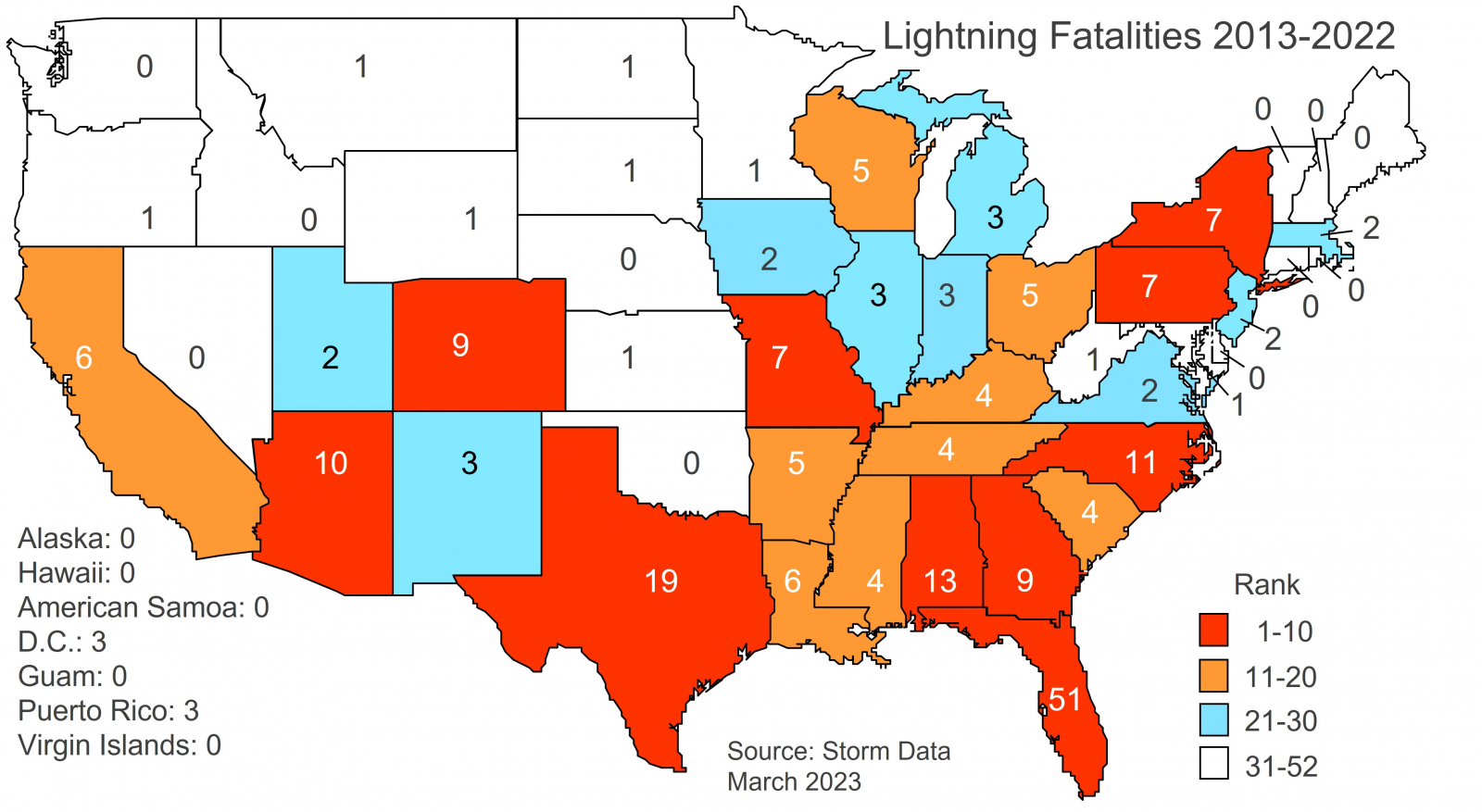
Fortunately, we have seen a steady decline in the number of lightning fatalities per year. We hope that bringing safety awareness will continue that trend.
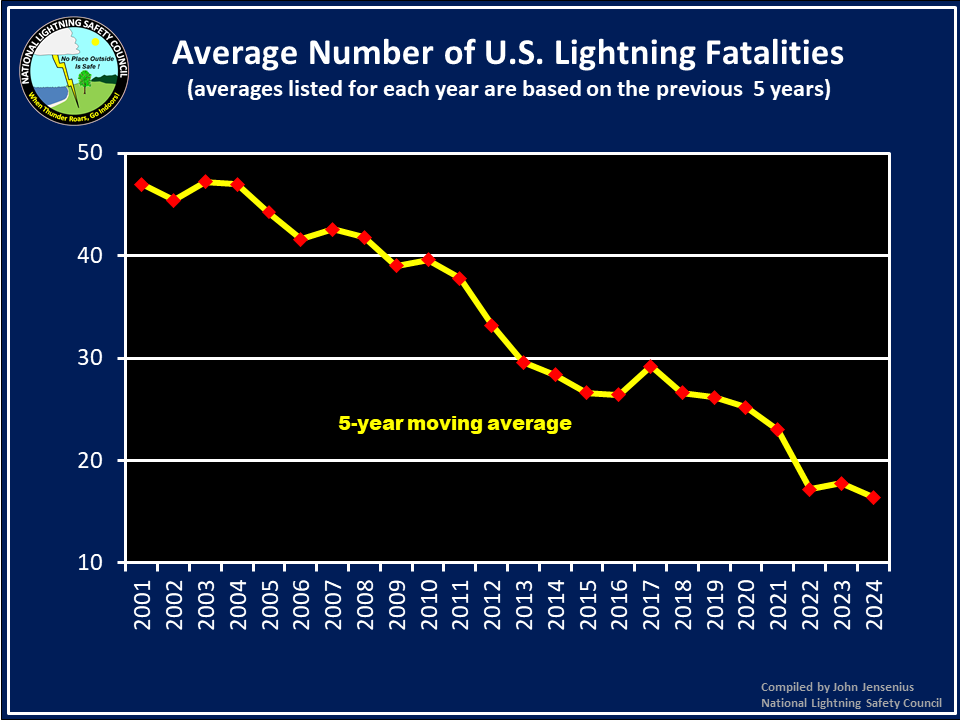
Males accounted for 80% of all fatalities, and about 90% of the deaths in the fishing, sports, and work categories. Females had comparatively fewer deaths than men in every category, with their highest percentages in the boating-related activities (32%) and routine daily/weekly activities (32%). Between 2006 and 2023, the majority of victims were male aged 10 to 60.
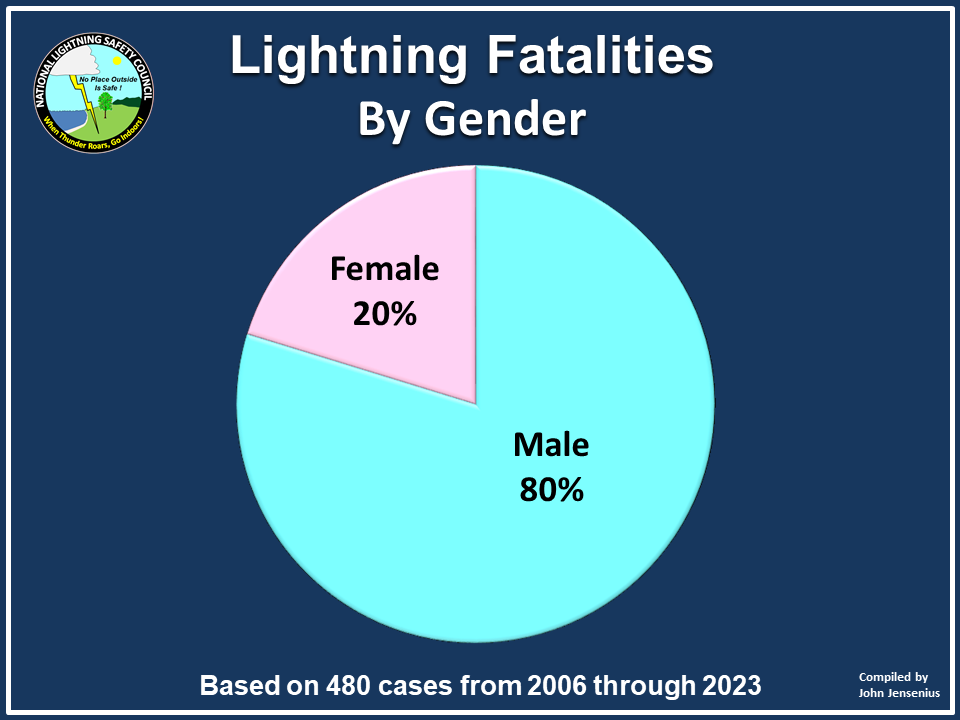
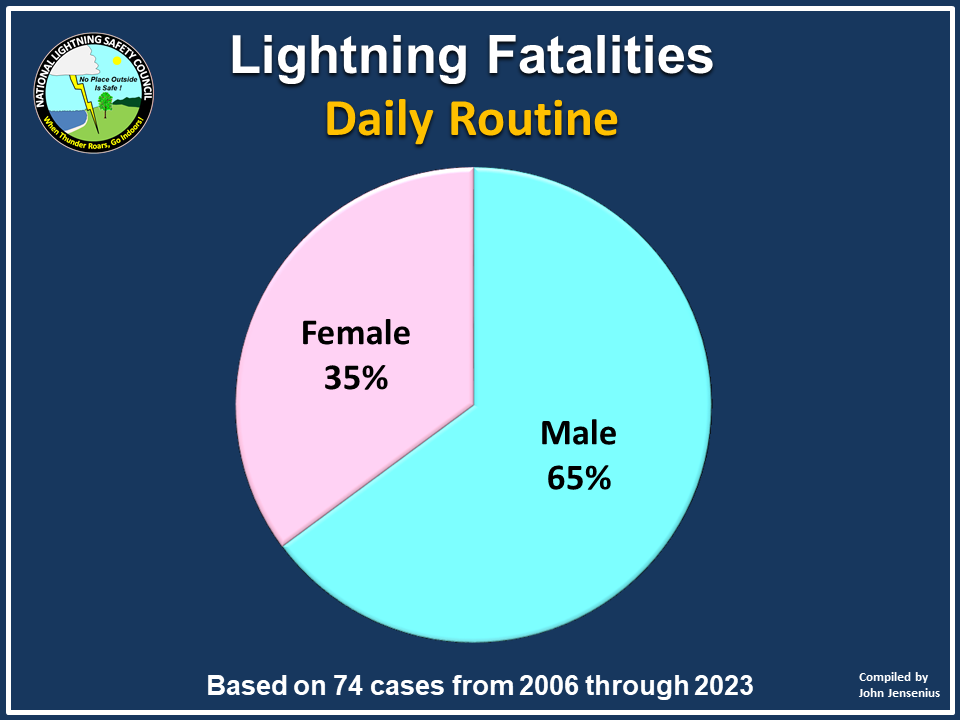
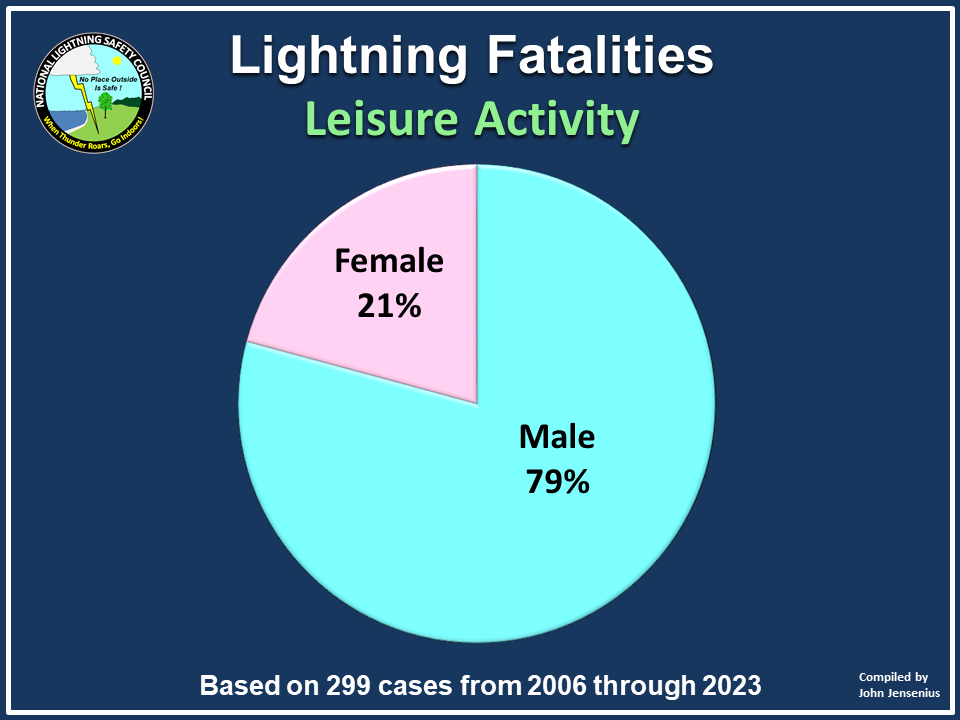
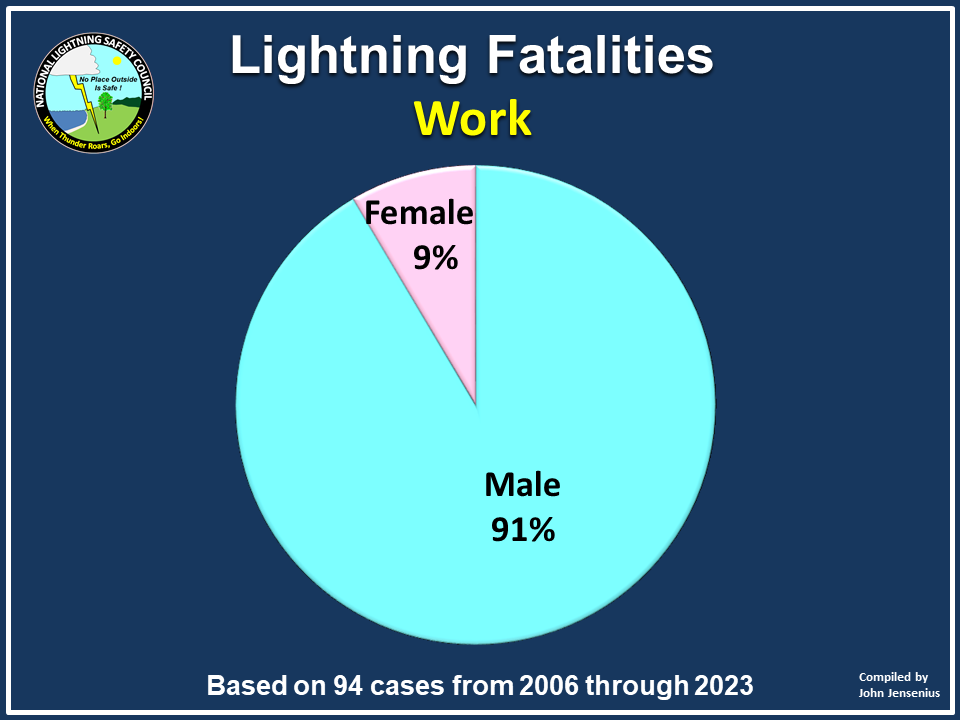
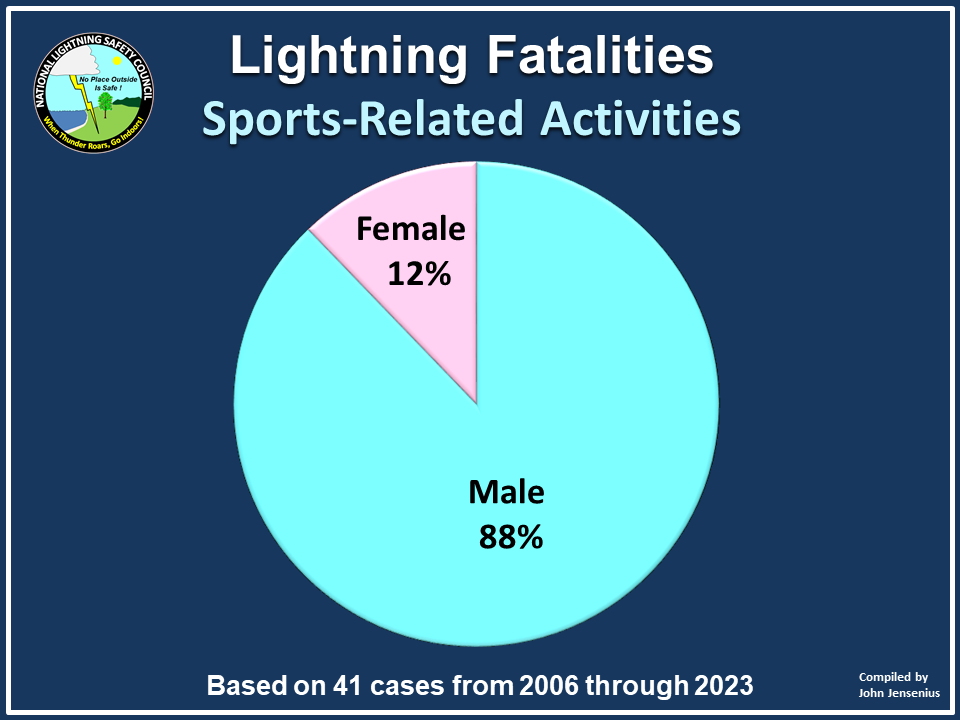
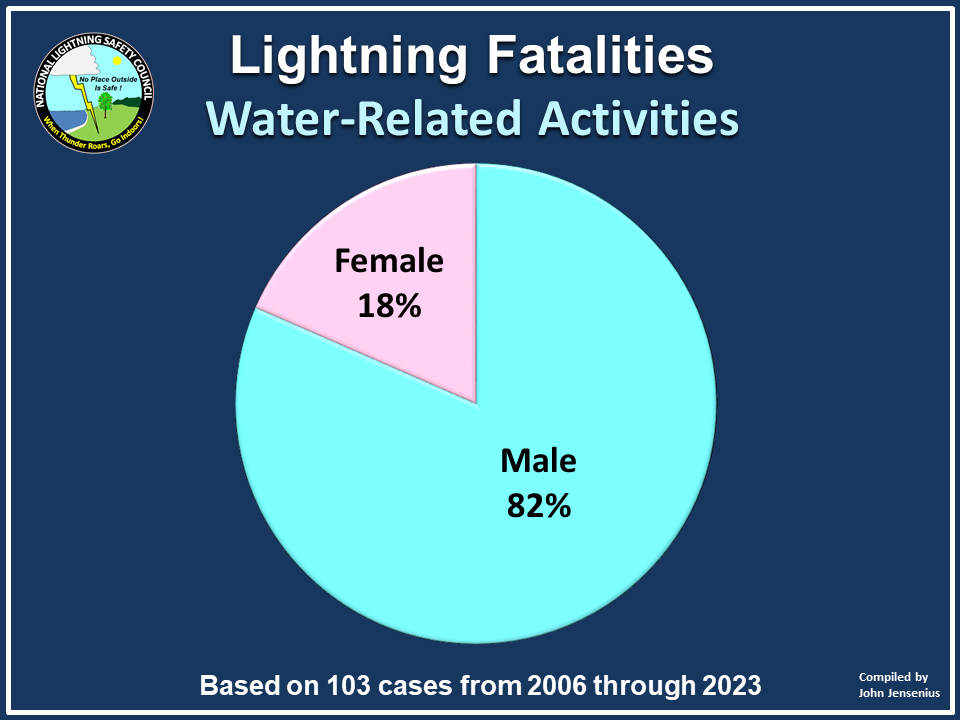
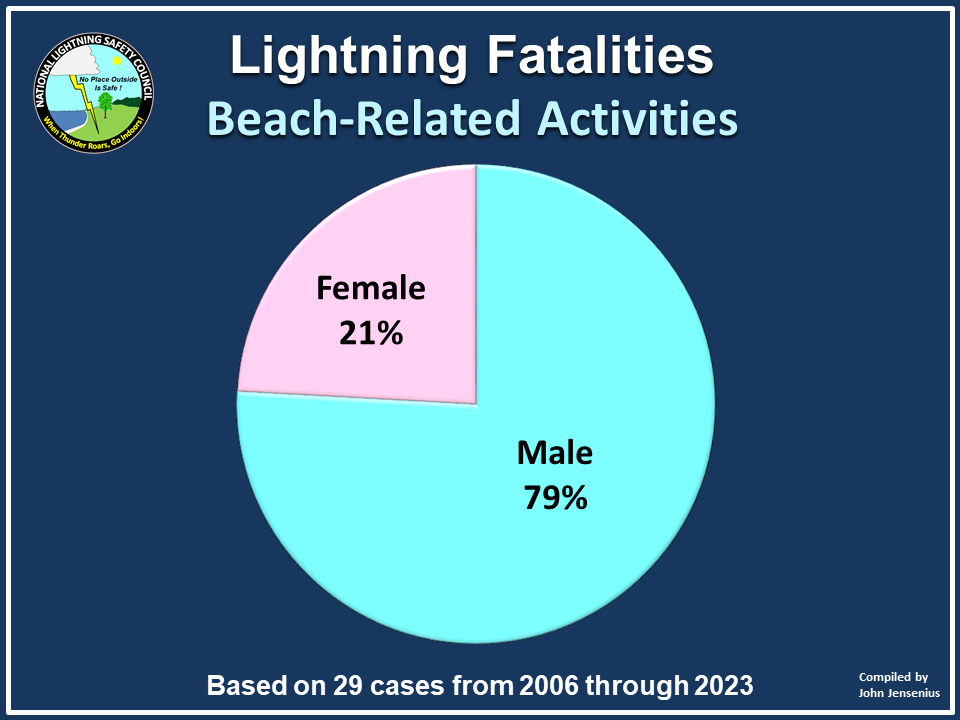
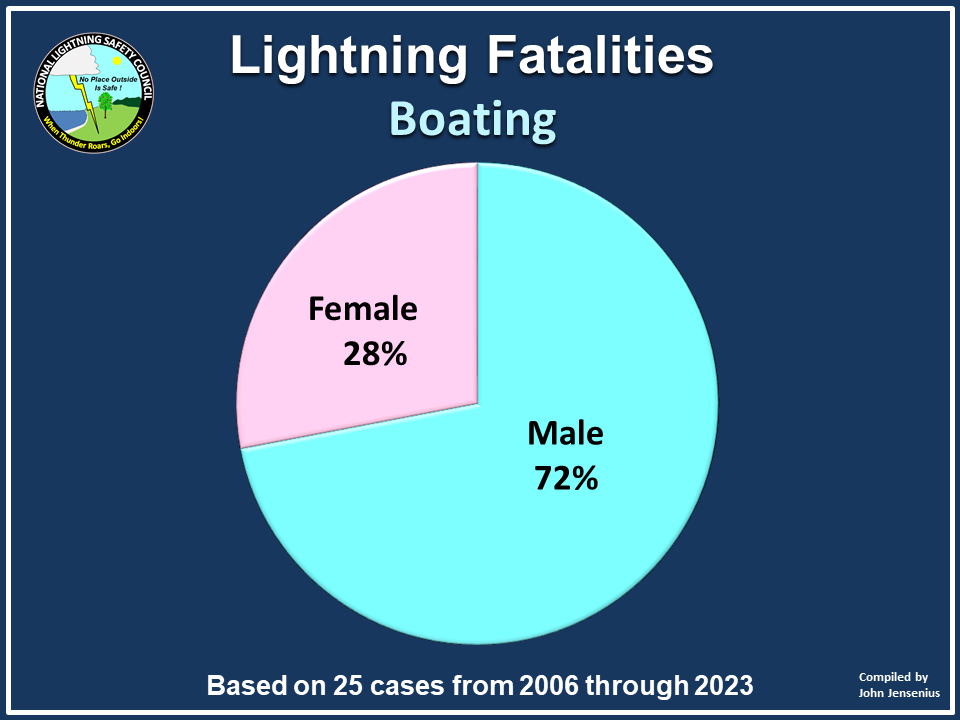
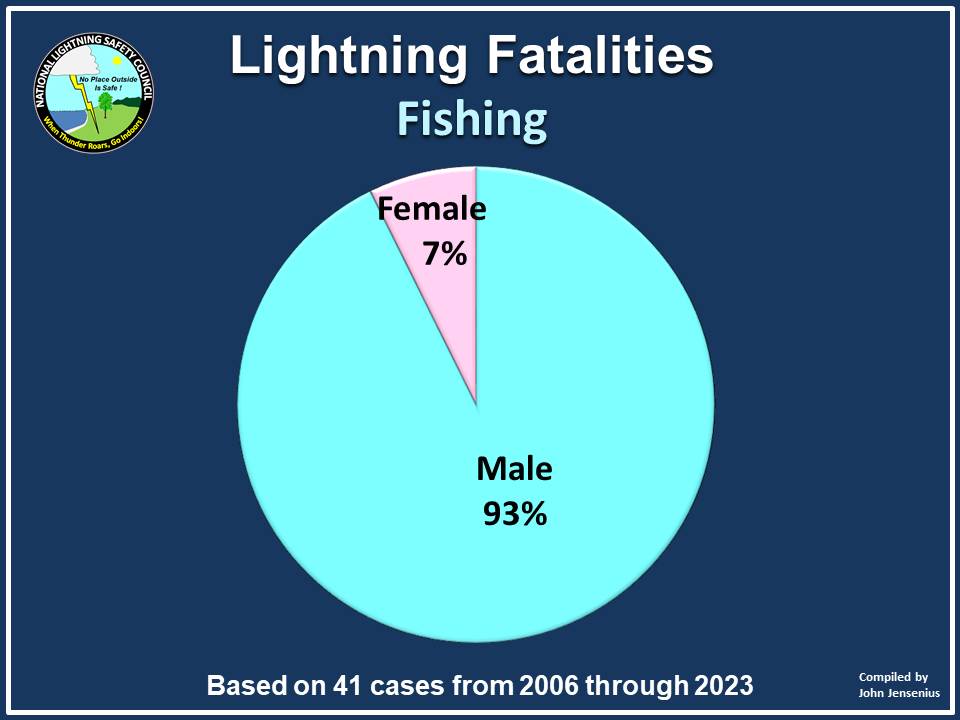
More than 70% of the lightning fatalities occur in June, July, or August. These months not only have the greatest amount of lightning activity in the U.S., but they are also the months when people spend more time outside enjoying a variety of recreational and leisure activities. While all days of the week see a significant number of fatalities, the weekend days, particularly Saturday, have the greatest number of fatalities. Presumably, this is because people spend more time outside and are involved in activities that make them more vulnerable to being struck.
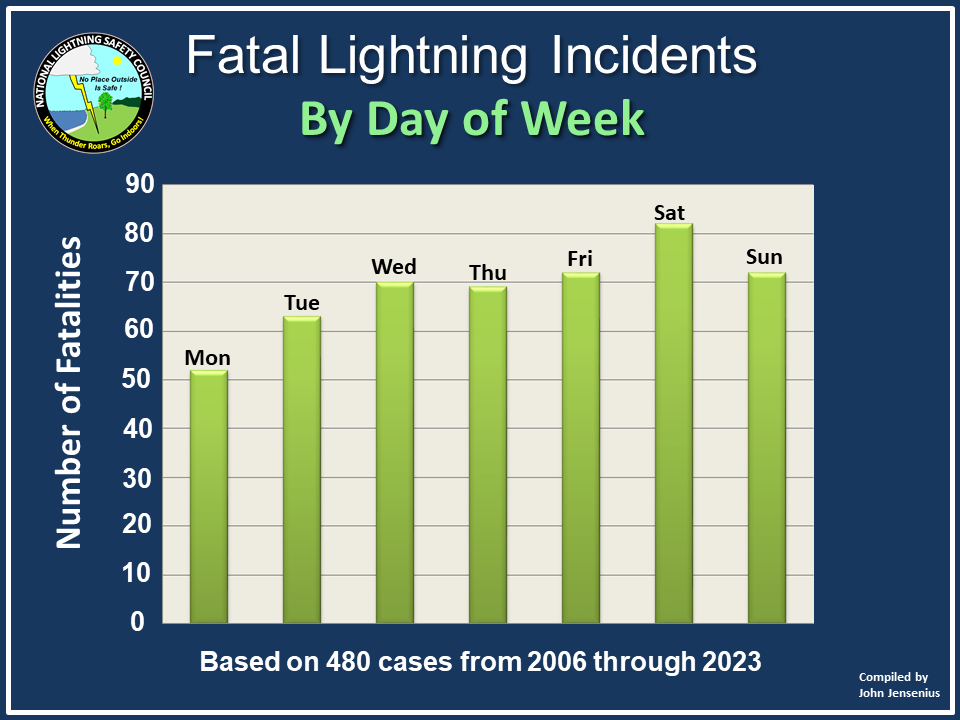
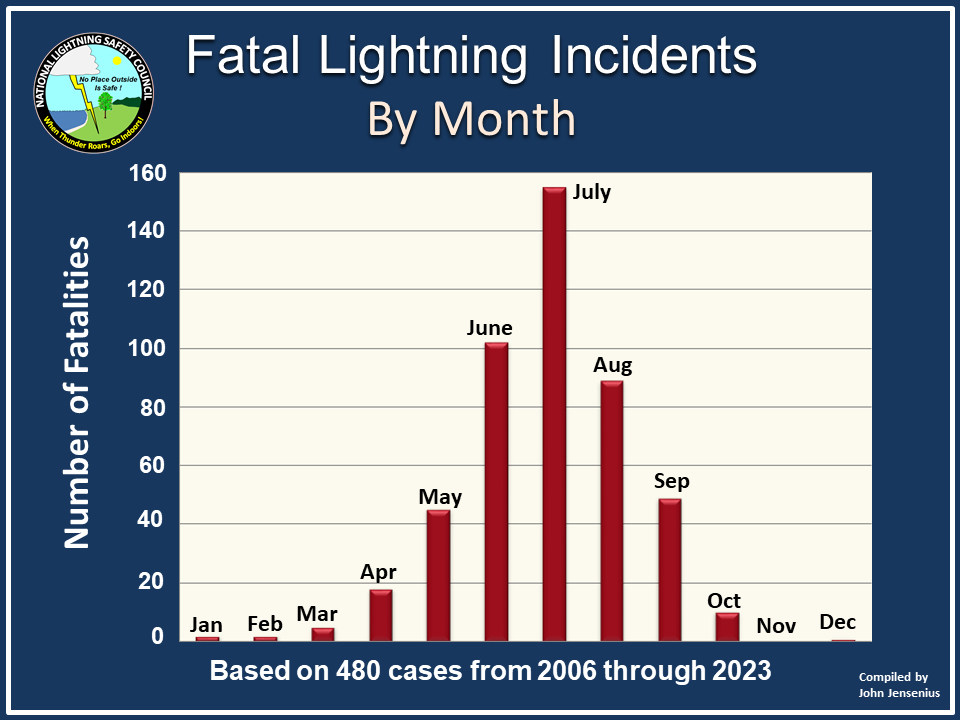
Ages of the victims varied from young children to older adults with the greatest number of fatalities between the ages of 10 and 60. Within that age range, the most fatalities occur in the 20-29 age group.
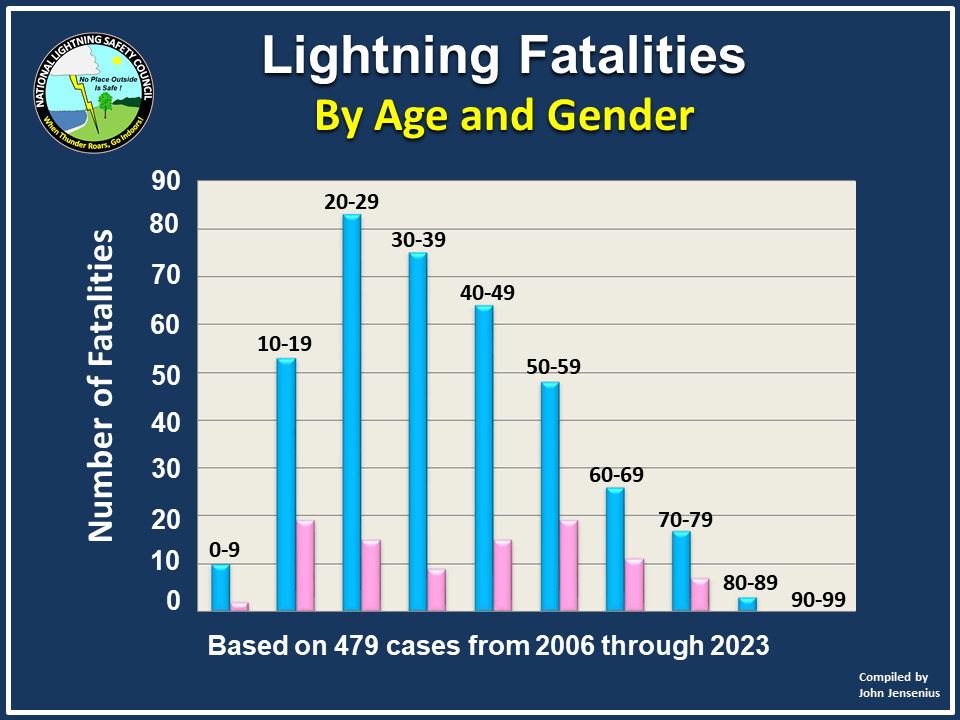
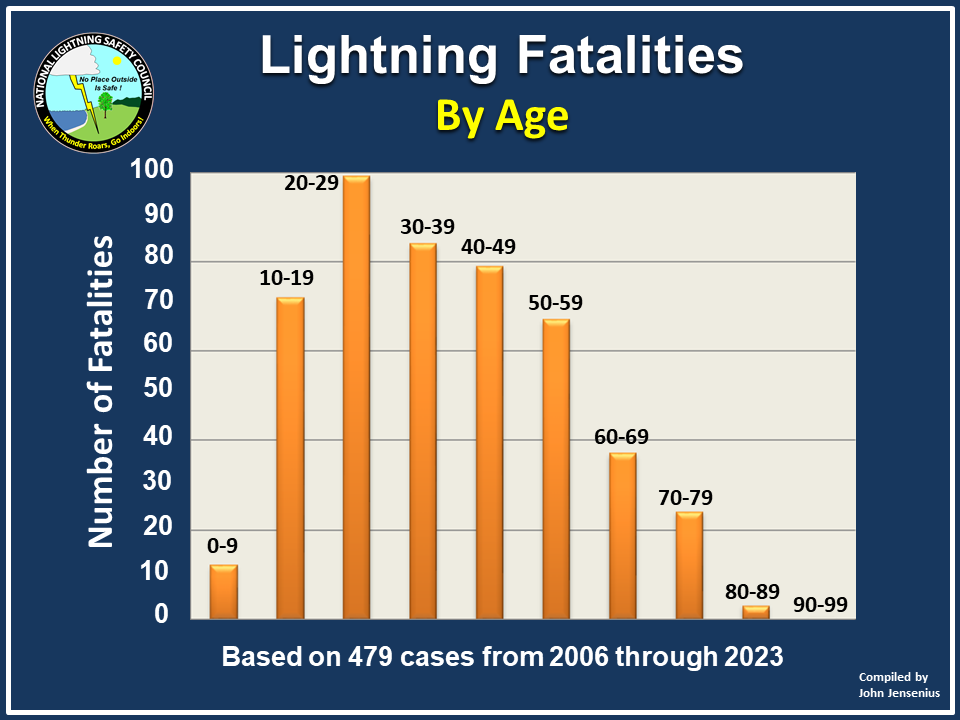
Science of Lightning
Lightning is simply a giant spark that moves within a cloud, between clouds, or between a cloud and the ground. As lightning passes through the air, it heats the air rapidly to a temperature of about 50,000 degrees Fahrenheit. This causes a rapid expansion of the air along the lightning channel. This rapid expansion causes a shock wave that we hear as thunder.
Every thunderstorm produces lightning. Thunderstorms will form if there is sufficient moisture and instability in the atmosphere. As the sun warms the air near the ground, pockets of warmer air begin to rise and cool. Condensation of water vapor causes cumulus clouds to form. Continued heating can cause these cumulus clouds to continue to grow upward into the atmosphere. Towering cumulus clouds may be one of the first indications of a developing thunderstorm. The mature thunderstorm has both an updraft of rising warm air and a downdraft of sinking cool air accompanied by rain and sometimes hail.
Thunderstorms grow tens of thousands of feet into the atmosphere. Within the thunderstorm, precipitation forms as ice crystals, graupel, and rain. Collisions between these particles causes electrical charges to separate, with the positively charged ice crystals carried up into the updraft, while the negatively charged heavier graupel are carried downward in the downdraft. With time, the top of the thunderstorm becomes positively charged and the lower part of the thunderstorm becomes negatively charged.
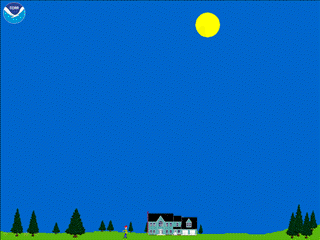

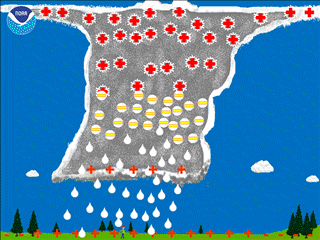
Due to the pool of negative charges in the lower part of the storm, a pool of positive charges will develop along the ground and follow the cloud base like a shadow. Farther away from the cloud base, but under the positively charged anvil, a strong negative charge may be induced along the ground.
Cloud-to-ground lightning can either be a negatively charged flash or a positively charged flash. The negative flash usually occurs between the negative charges in the lower part of the storm and the positive charges on the ground under and near the cloud base. Positive flashes usually occur between the positively charged upper levels of the storm and the negatively charged area surrounding the storm.
In the negative cloud-to-ground flash, a negatively-charged step leader forms and begins to move down toward the ground. As this step leader approaches the ground, streamers of positive charge move upward from the Earth's surface. When these upward streamers meet the step leader, the connection is completed and the result is a cloud-to-ground lightning flash. The entire process takes place in fractions of a second. If you are near, or under a thunderstorm, and your hair rises, you are in an area where the positive electrical charges are rising up objects towards the storm. You are in a very dangerous location, because lightning may be about to strike!
The process for a positive flash is similar except that a positive channel usually originates in the anvil of the storm and surges downward. In this case, streamers of negative charge shoot up to meet the positively charged channel as it approaches the ground. When a connection is made, a positive flash of lightning occurs.
While both negative and positive flashes of lightning can be deadly, the positive flashes generally are more destructive as they typically deliver more overall electrical charge to the ground, and they remain in contact with the ground surface for a relatively longer period of time as compared to a negative cloud-to-ground flash.

Did you know that lightning is hotter than the surface of the Sun?
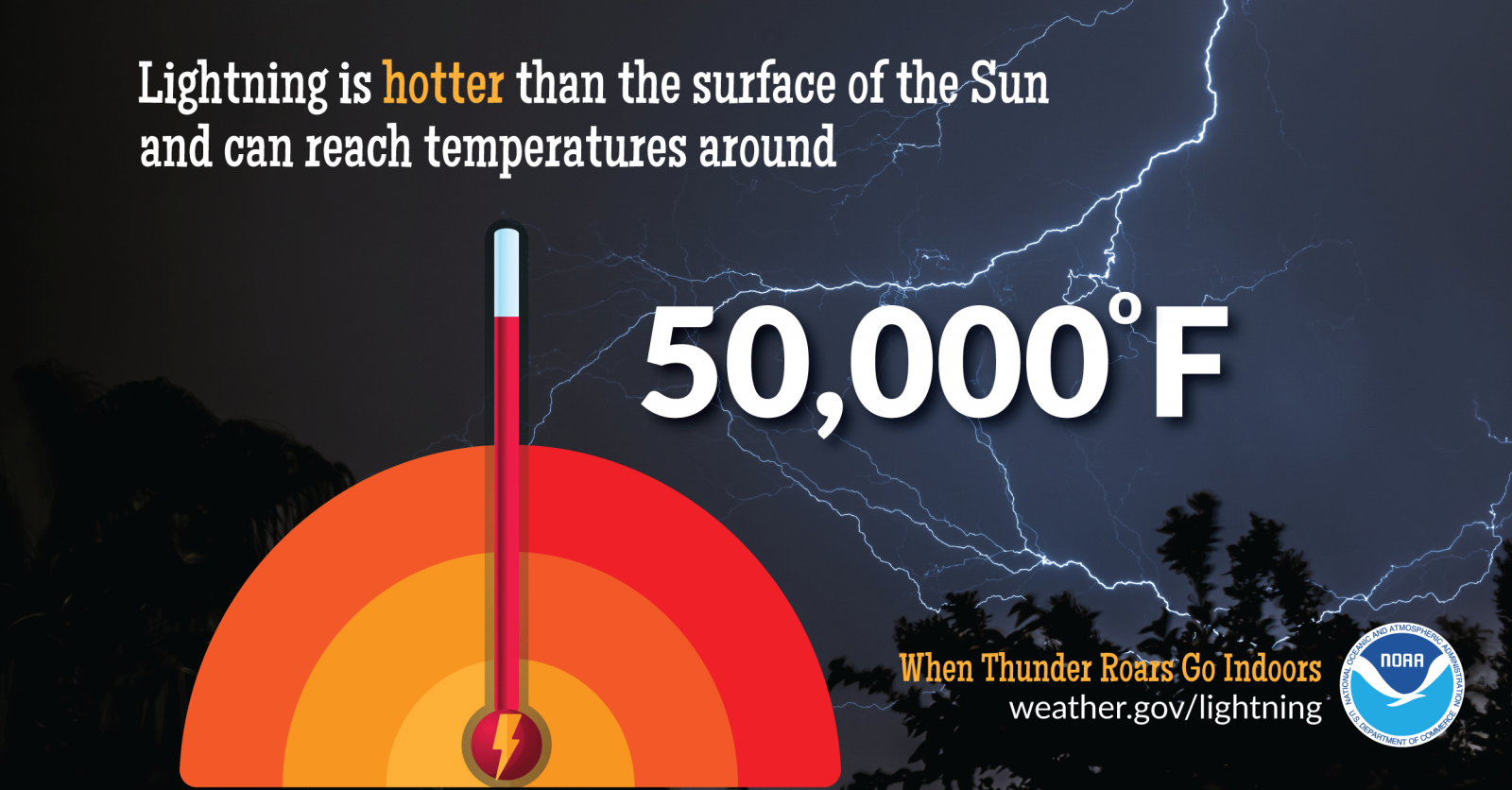
Outdoor Lightning Safety
Outdoors is the most dangerous place to be during a thunderstorm. Each year, nearly all people in the United States who are injured or killed by lightning were involved in an outdoor activity. They were struck while working outside, were at or participating at an outdoor sporting event, or were boating or fishing. Other examples include people struck while they were hiking, mowing the lawn or simply going to or from their car. Quite a few were on their own property when they were struck.
Unfortunately, there is no place outside that is safe from lightning. The only safe place to be when lightning is occurring is either inside a substantial building, or an enclosed automobile. If you are outside, such as a park, a lake, or an outdoor sporting event, know where the nearest safe location can be accessed. A safe location is any substantial building (a substantial building is a structure which is fully enclosed and has electrical wiring and plumbing). In addition, any enclosed hard-topped car or truck also offers excellent protection from a lightning strike.
Once you hear thunder or see lightning, immediately stop what you are doing and quickly get to the safe shelter. What can you do to reduce your chances of being injured or killed by lighting if no safe shelter is nearby? Unfortunately, in this scenario, there is not much you can do to reduce your risk from being struck by lightning. The best thing to do is move away from tall isolated objects, such as trees. Stay away from wide open areas. Stay as low as possible with your feet close together if lightning is nearby. If you are with a group of people, spread out, that way if someone is struck by lightning, the others can offer first aid.
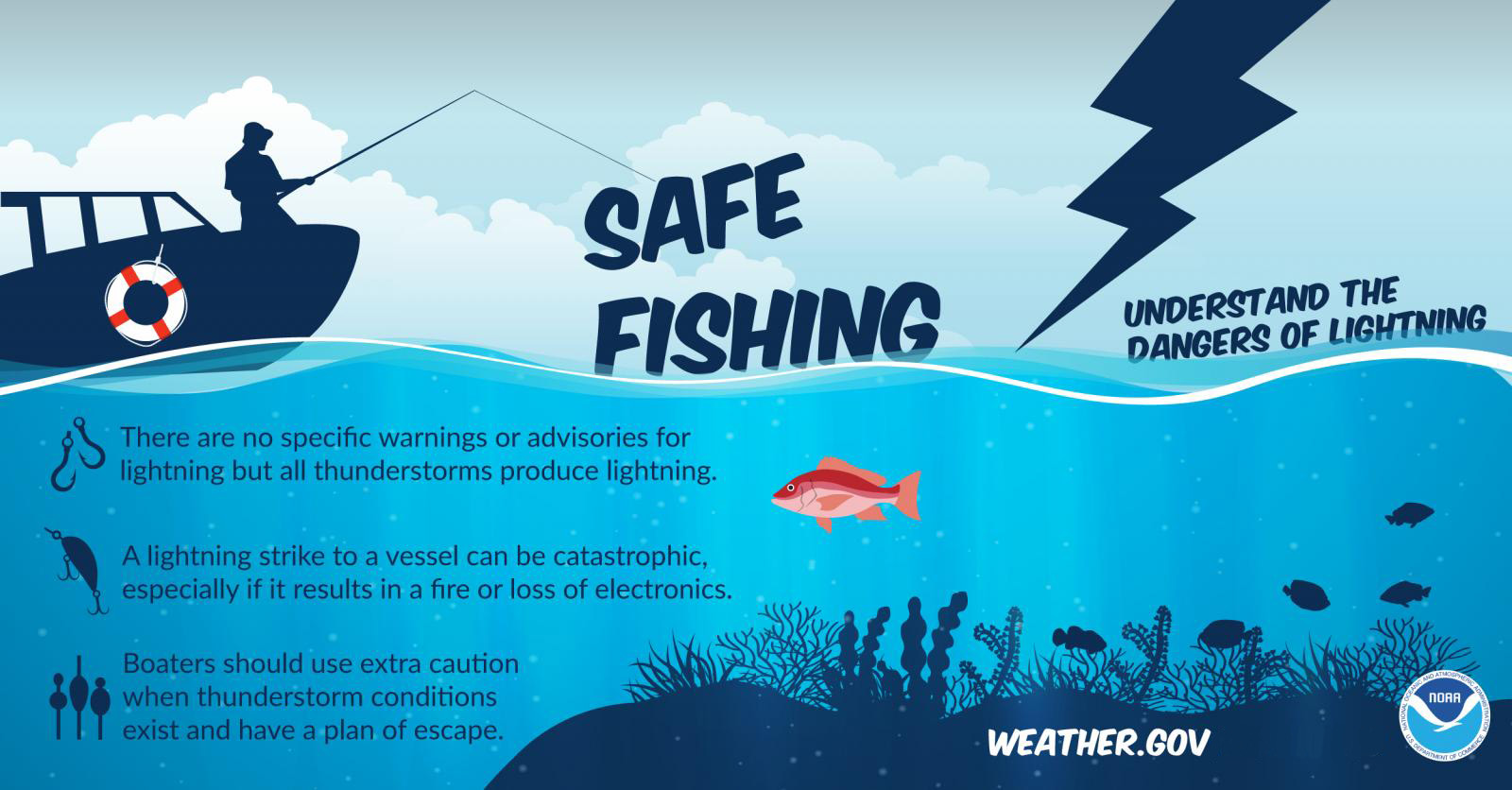
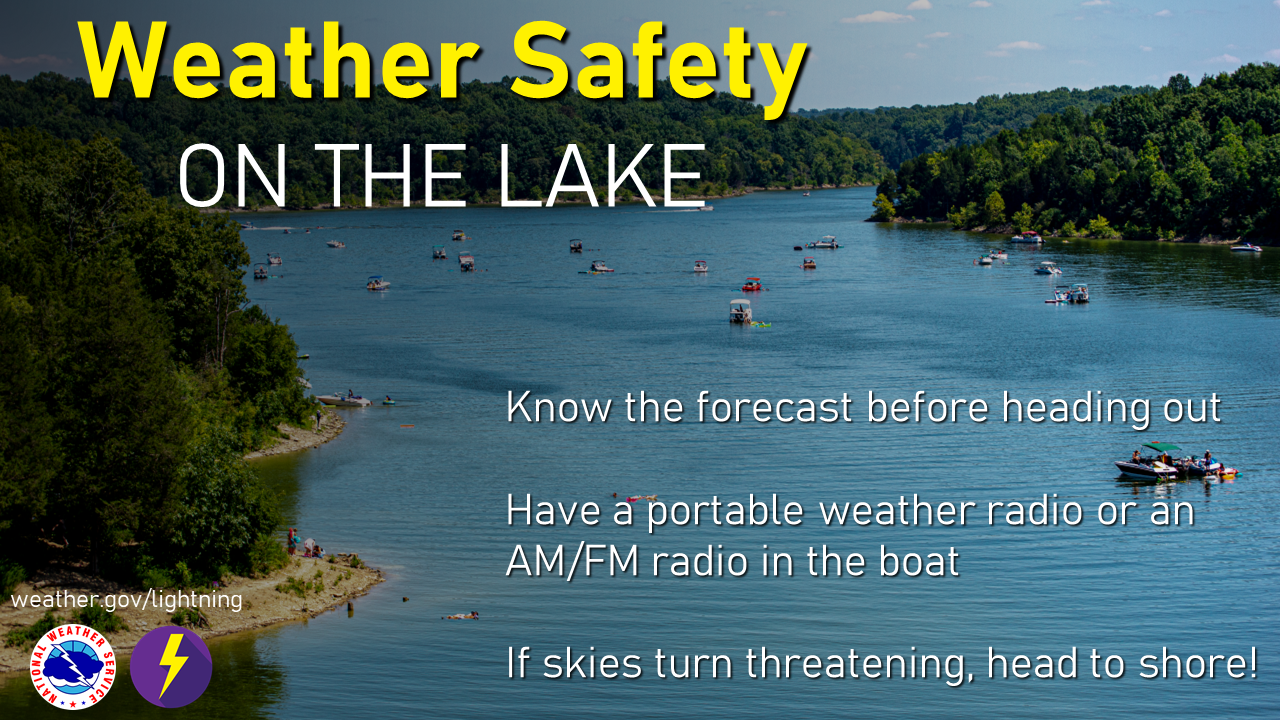

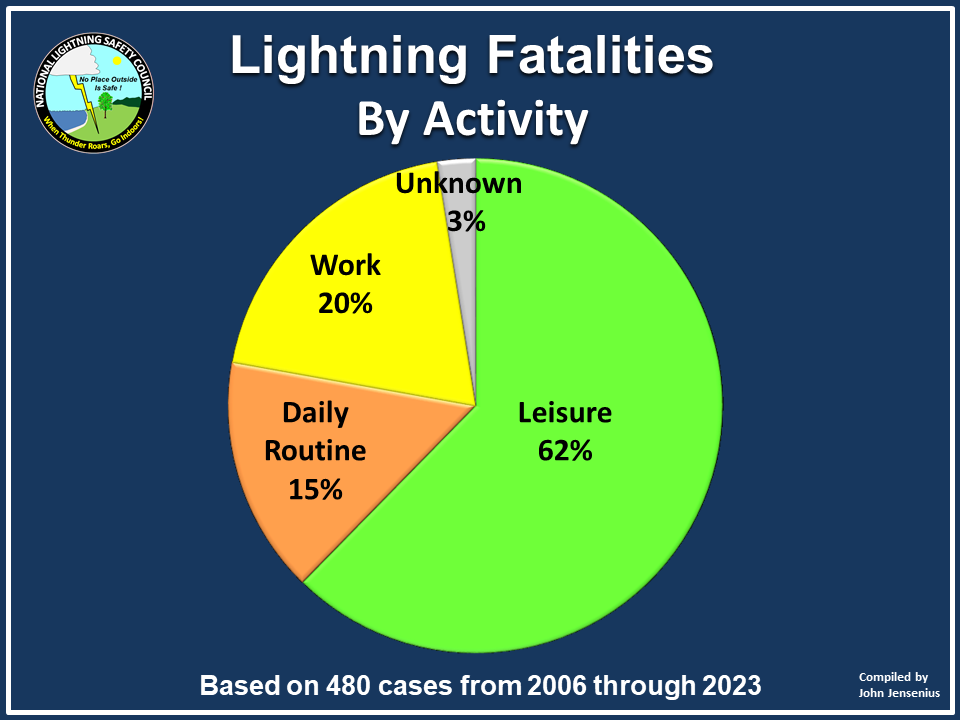
Fishing contributed most (40%) to the water-related deaths with boating (power boats, jet skis, canoes, sailboats, tubes) adding another 24%. About 28% of the victims were involved in beach related activities, while about 8% of the victims had been swimming. The data also shows that leisure-related activities are the greatest source (62%) of lightning fatalities. In particular, the combination of fishing and boating activities accounts for 14% of all lightning deaths. These activities are especially dangerous because fishermen and boaters are likely to be out in the open and more vulnerable to a direct lightning strike; the background noise from a motor or waves may limit their ability to hear thunder; and they may need extra time to get to a safe place.
Work-related activities contributed to 20% of the total lightning fatalities. The graphic shows the breakdown of the work-related deaths. Farming and ranching contributed most (24%) to the work-related deaths. Additional fatal activities included roofing (21%), construction (17%), lawn care (10%), military work (4%), and other (23%). Included in the “Other” category were deaths related to barge work, loading and washing trucks, surveying, door-to-door sales, logging, mail delivery, tornado rescue, utility repair, building maintenance, pruning trees, inspecting seawalls, washing oil disposal tanks, working at an amusement park, working on a billboard, lifeguarding, and attending beach umbrellas.
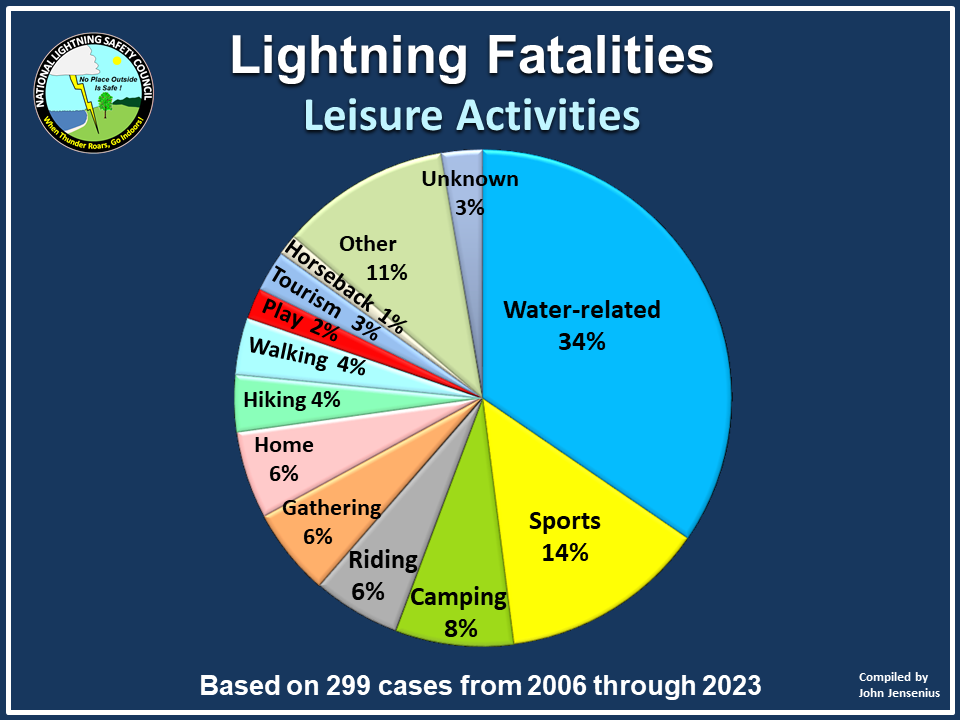
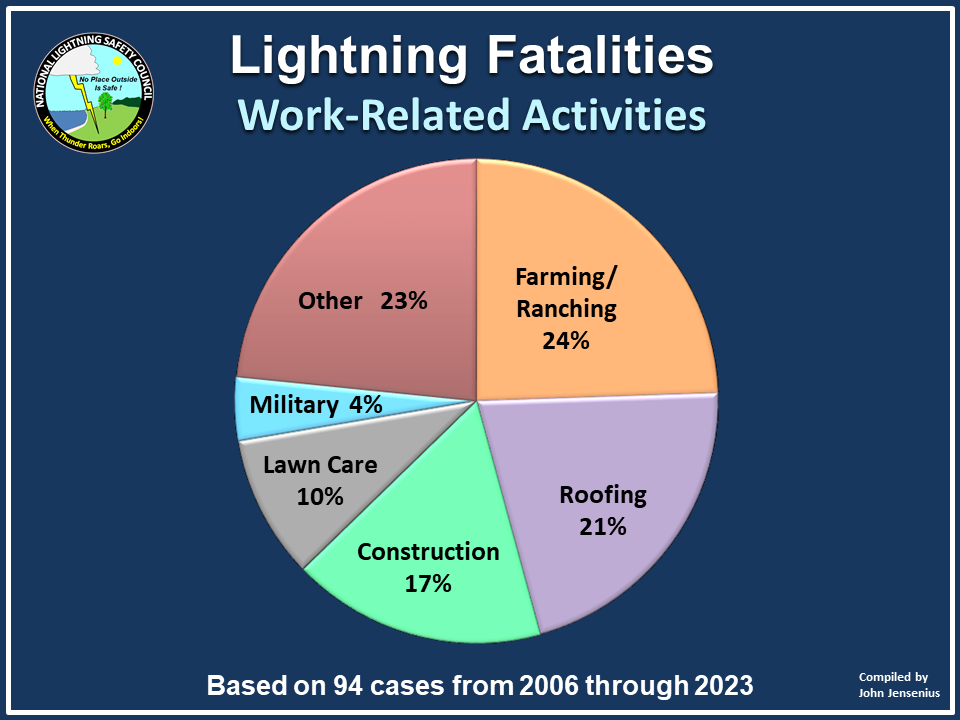
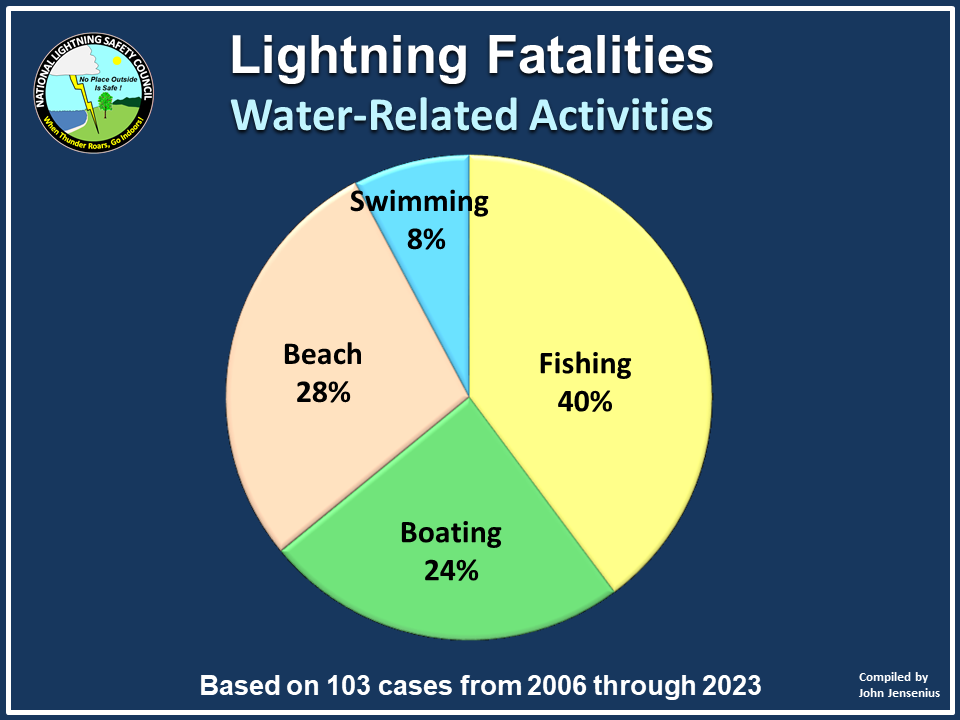
Certain activities limit a person's ability to monitor conditions. In particular, any background noise may limit a person's ability to hear distant thunder from an approaching or nearby storm. Mountains, trees, or buildings may impair a person's view of the horizon and limit the ability to watch for signs of developing storms. Recent advances in cell phone technology and the availability of lightning notification services may help provide advance warning in these situations.
Camping contributed significantly to the lightning death toll. In many cases, the victims were only steps away from a vehicle that could have provided safety. In some of these cases, skies may have been obscured by mountains or trees, and the victims just didn't realize a storm was nearby. In other cases, though, the threat was likely ignored. In a few cases where the fatal incident was in a remote area far from a safe place, there may have been little or nothing the victim could do at that time to be safe. In these cases, canceling or postponing the activity may have been the only course of action that would have provided safety
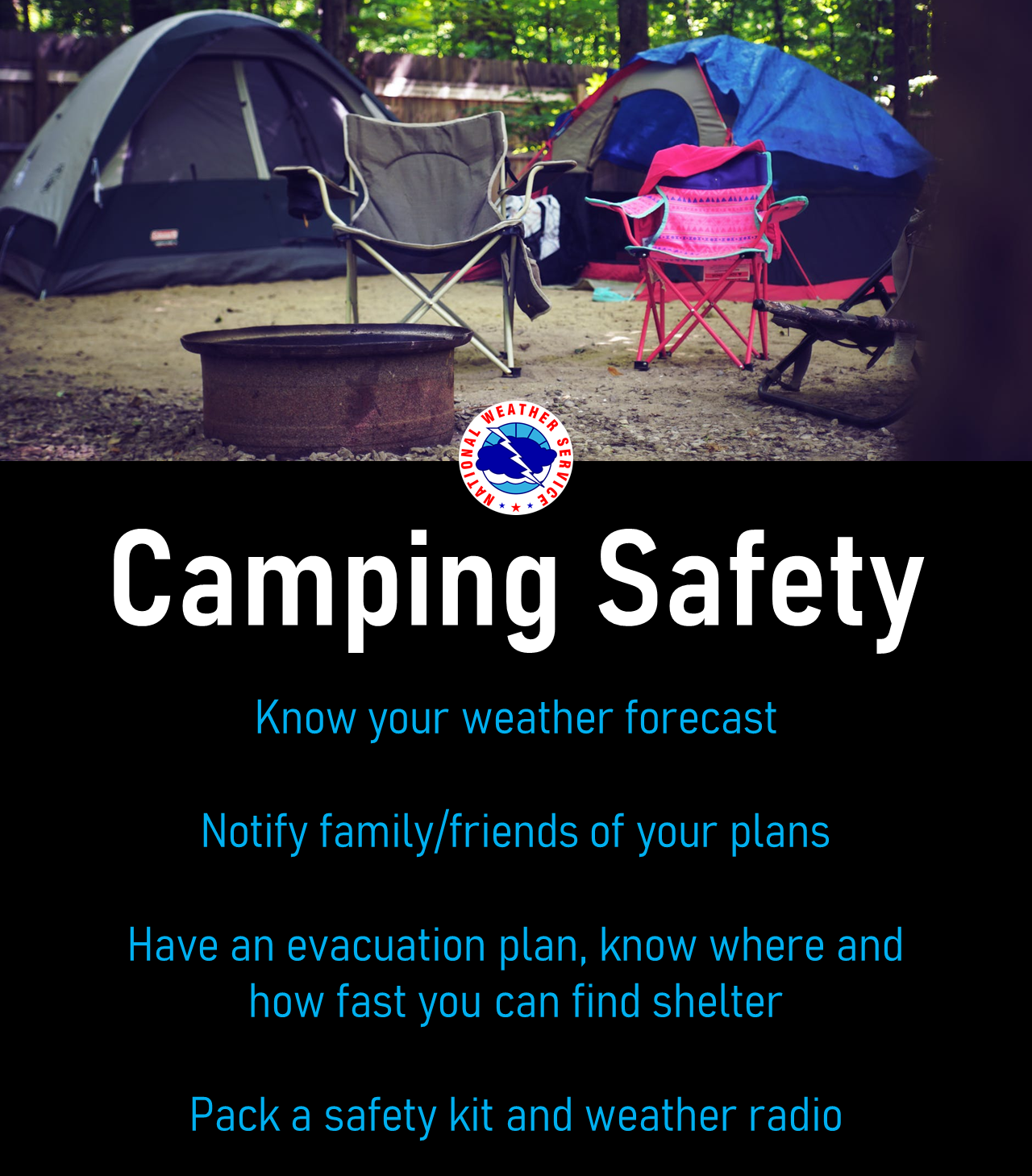
Indoor Lightning Safety
Statistics tell us that we are much less likely to become a lightning strike victim if we are inside a substantial structure such as a home or office building. While the majority of people who are injured or killed by lightning are outside, a small percentage of people are injured by lightning while indoors. Therefore, it is important to discuss indoor lightning safety.
The dangerous electrical current associated with a lightning strike typically enters a structure through wires, cables or pipes that connect to the building from the outside. Lightning can also directly enter into a structure through an open window, door or garage door. Once in a structure, the dangerous current can travel through the electrical, phone, cable and plumbing systems and through metal wires or bars in concrete walls or flooring.
Corded electronic devices are the leading cause of indoor lightning injuries in the United States. These include personal computer keyboards, game consoles, and corded phones. Other injuries have occurred when people were close to televisions which connect to an outside cable or satellite system. Open windows, doors and garage doors allow for a direct strike to enter a home, so make sure all windows and doors are closed when lightning is occurring. Never watch a lightning storm from a porch or open garage door. There are several YouTube videos that show people being injured by lightning while they were recording lightning from their porch or open garage door.
It is very important to stay away from any plumbing when lightning is occurring outside. This includes sinks, bathtubs and showers. When lightning is occurring, do not hand wash dishes, do not give kids a bath, and do not take a shower. It is best to wait to do laundry until after the storm goes by as washers and dryers are connected to both the electrical and plumbing systems.
People have also been injured while leaning and standing near concrete in their homes and offices. This is due to metal rebar which is in the concrete, and this metal acts as a conductor when lightning hits the building.
A house or other substantial building offers the best protection from lightning. In contrast, many small shelters such as bullpens, picnic shelters, sheds or tents (no matter what the size) offer no protection from lightning, and should be avoided at all cost.
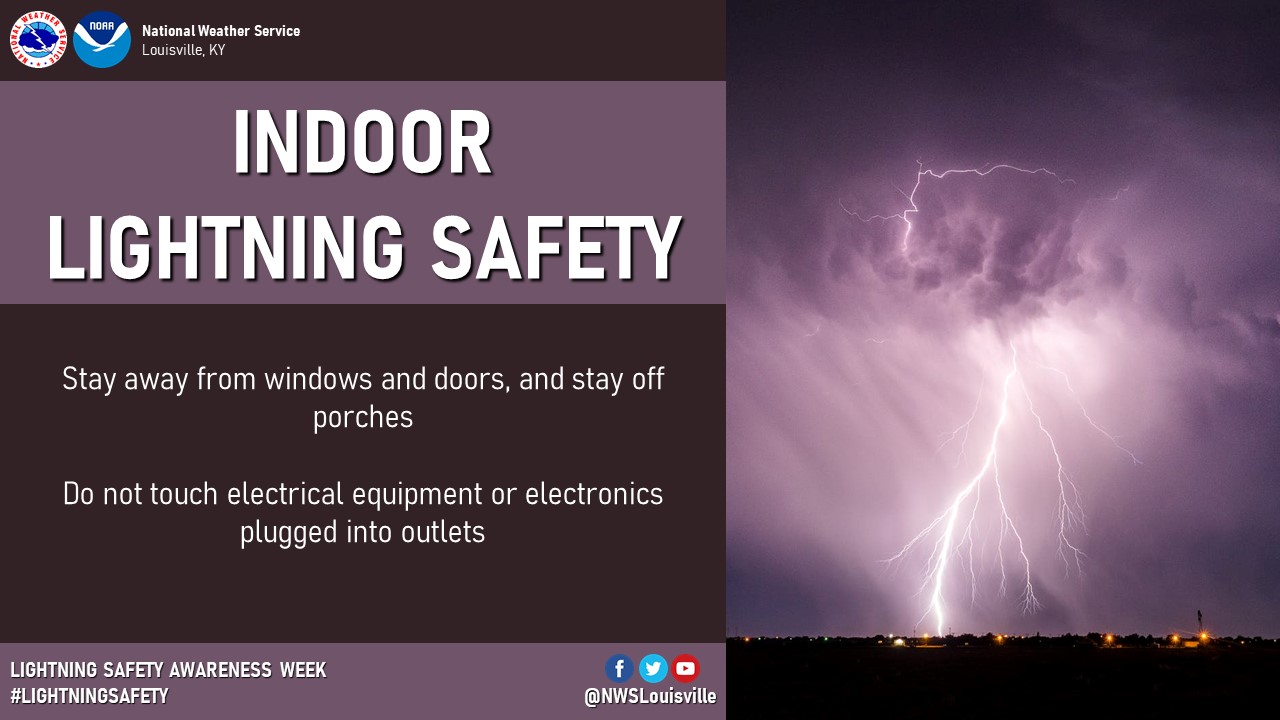

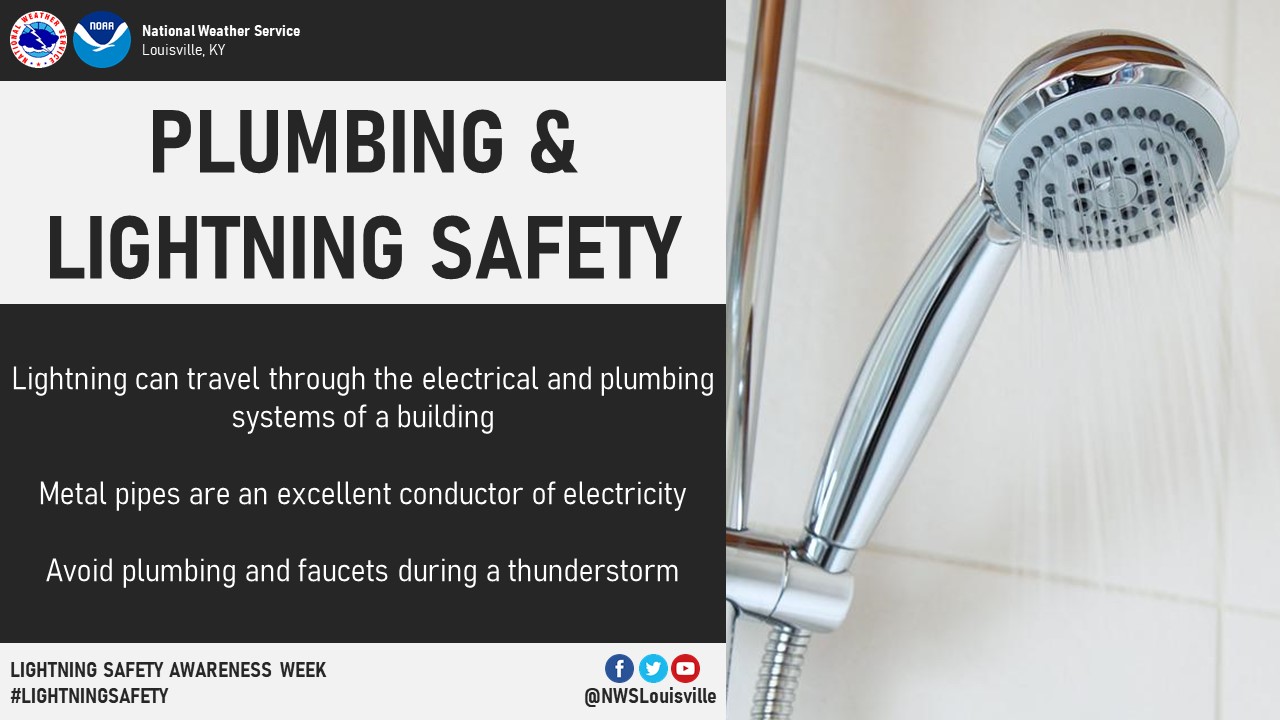
Lightning and Sports
Lightning strikes can result in death or serious injury. If you hear thunder or see lightning, take shelter in an enclosed building or a hard-topped vehicle with the windows up. Officials responsible for sports outdoor activities need to understand thunderstorms and lightning to make educated decisions on when to seek safety. Without this knowledge, officials may base their decisions on personal experience and or a desire to complete the activity. Unfortunately, decisions based on past experience or a desire to complete the activity can put the lives of those involved at risk.
For organized outdoor activities, the National Weather Service recommends that organizers have a lightning safety plan and follow it without exception. The plan should give clear and specific safety guidelines to eliminate errors in judgment. These guidelines should address the following questions.
When should activities be stopped?
Where should people go for safety?
When should activities be resumed?
Who should monitor the weather and make the decision to stop activities?
What should be done if someone is struck by lightning?
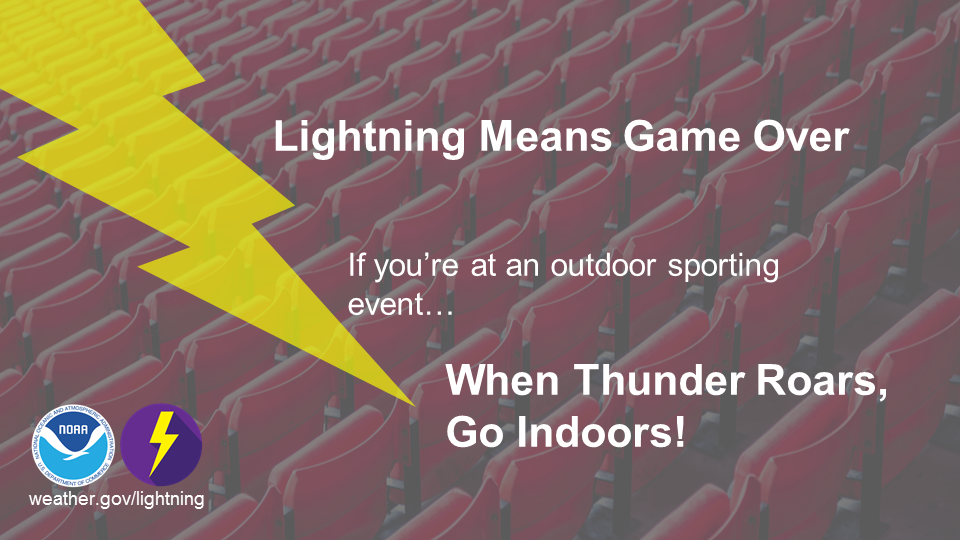
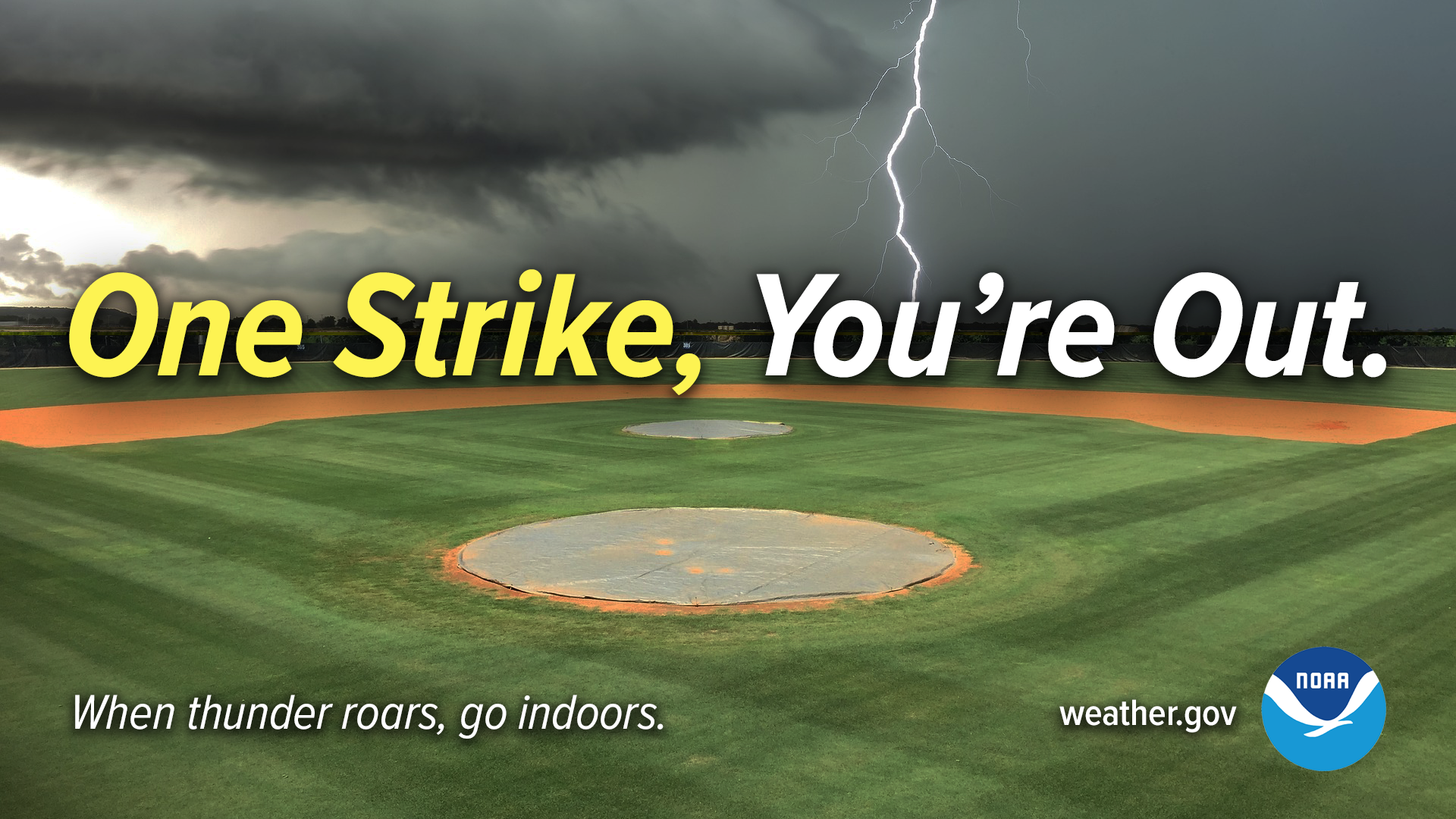

Soccer and golf contributed most to the sports-related deaths, followed by running (22%), baseball (7%), football (2%), and disc golf (2%). Sports-related activities contributed to about 9% of the total lightning deaths, with soccer and golf contributing most to the death toll. For most incidents, safety was nearby in the form of a building or vehicle. Many victims failed to react quickly to the imminent danger. A few of the running victims were some distance from safety and could have reached a safe place sooner had they listened to the forecast and chosen a safer route.
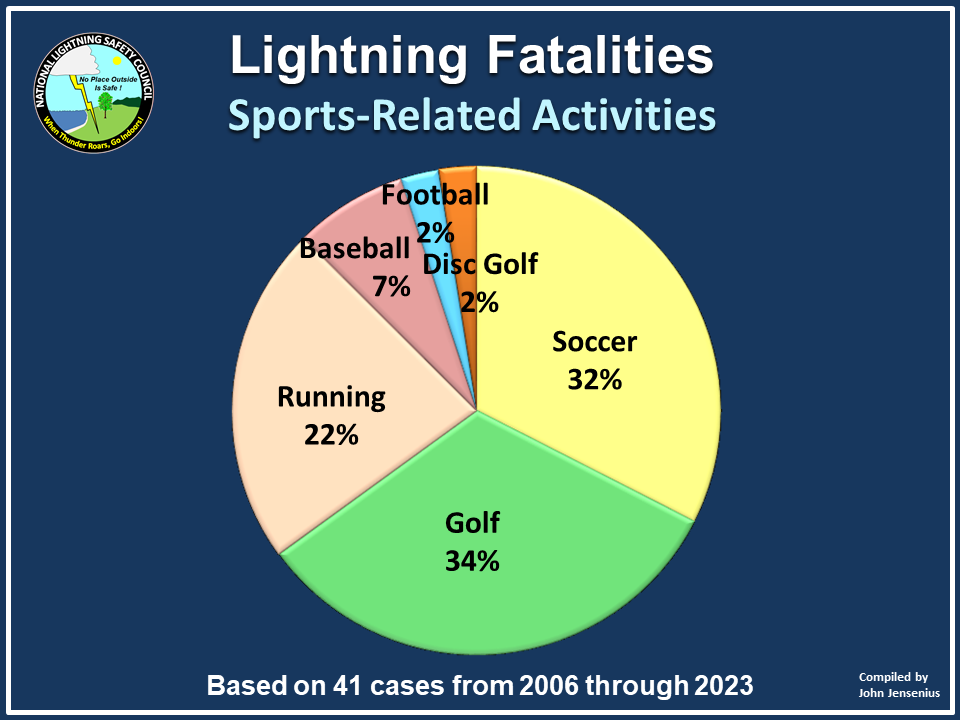
Both the inability and unwillingness to get to a safe place in a timely manner contribute to many lightning fatalities. Many people wait far too long to start heading to safety, and that puts them in a dangerous and potentially deadly situation. In fact, a number of lightning victims in this study were seeking safety when they were struck – the problem is that they just didn't start soon enough. In some cases, people decided to wait to see if the conditions improved rather than heading toward safety immediately. It's important to note that some activities require a considerable amount of time to get to a safe place. In those instances, it is imperative that people in charge or involved in the activities monitor conditions so everyone involved can get to safety immediately at the first signs of a developing storm.
General Safety Tips
There is no safe place outside when thunderstorms are in the area. If you hear thunder, you are likely within striking distance of the storm. Just remember, When Thunder Roars, Go Indoors. Too many people wait far too long to get to a safe place when thunderstorms approach. Unfortunately, these delayed actions lead to many of the lightning deaths and injuries in the United States.
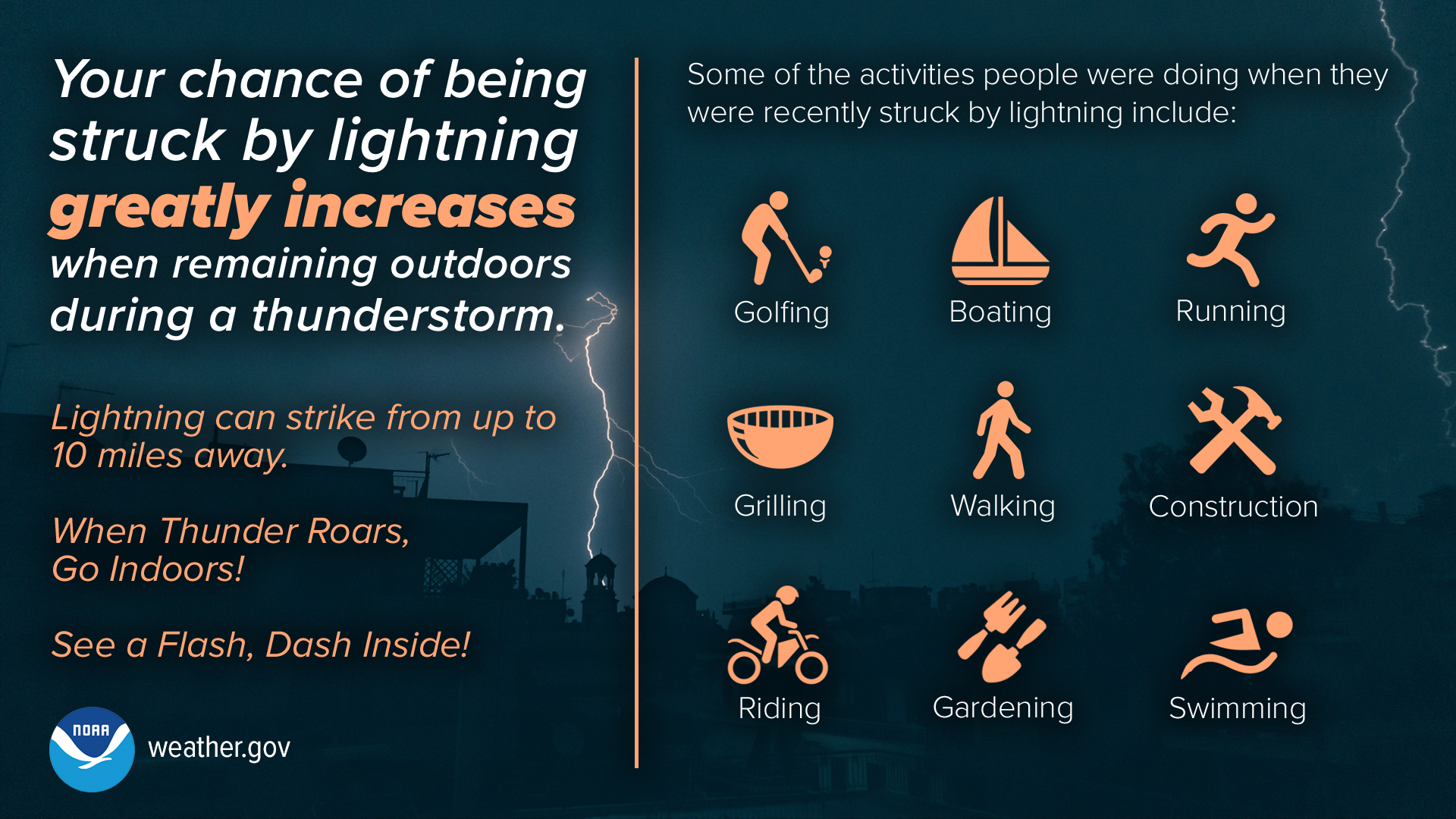
.png)
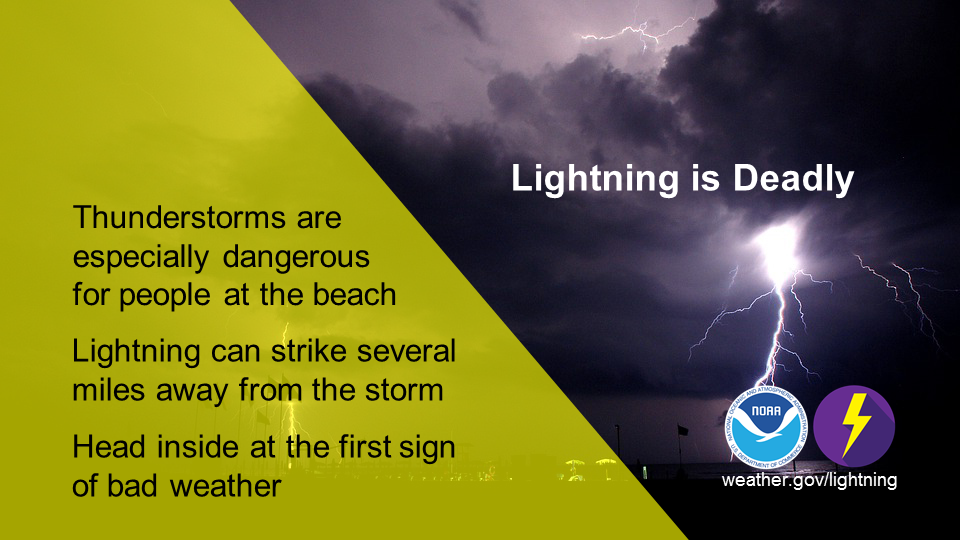
Last Resort Outdoor Risk Reduction Tips
If you are caught outside with no safe shelter anywhere nearby the following actions may reduce your risk:
Lightning Myths and Facts
There's many myths about lightning strikes. Take a look below at some of the more commonly heard ones and learn about the facts.
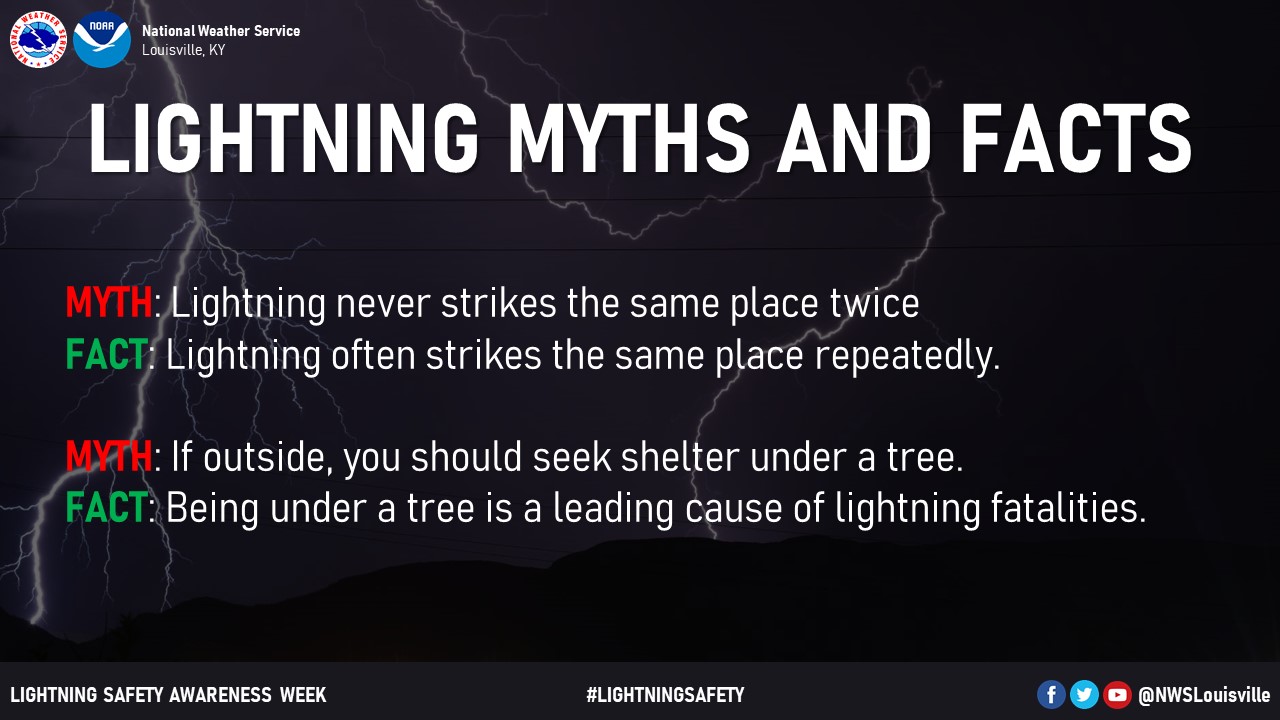
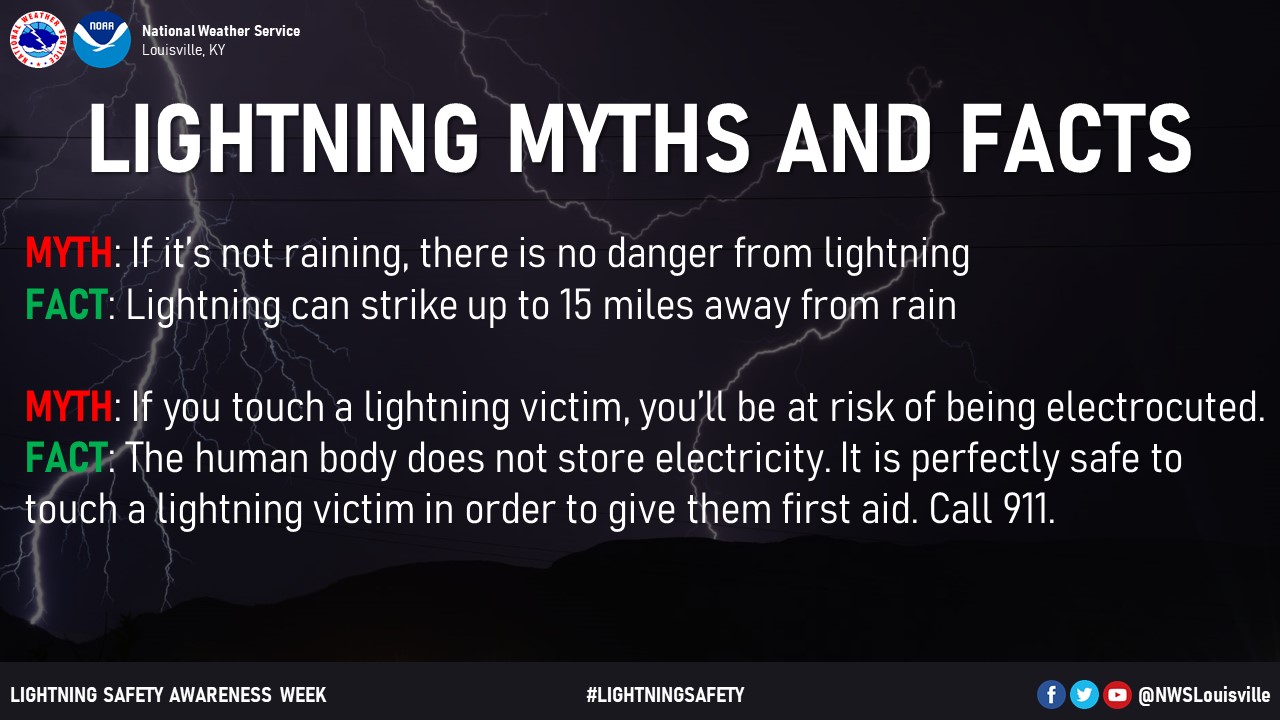
.jpg)
 |
Media use of NWS Web News Stories is encouraged! Please acknowledge the NWS as the source of any news information accessed from this site. |
 |